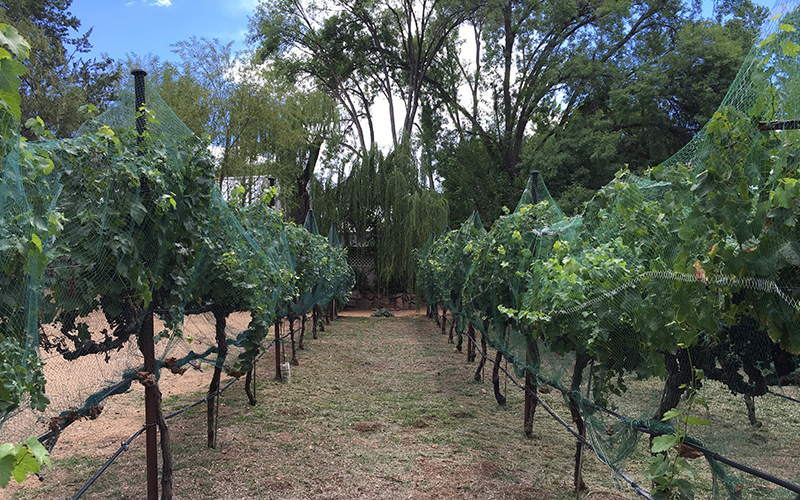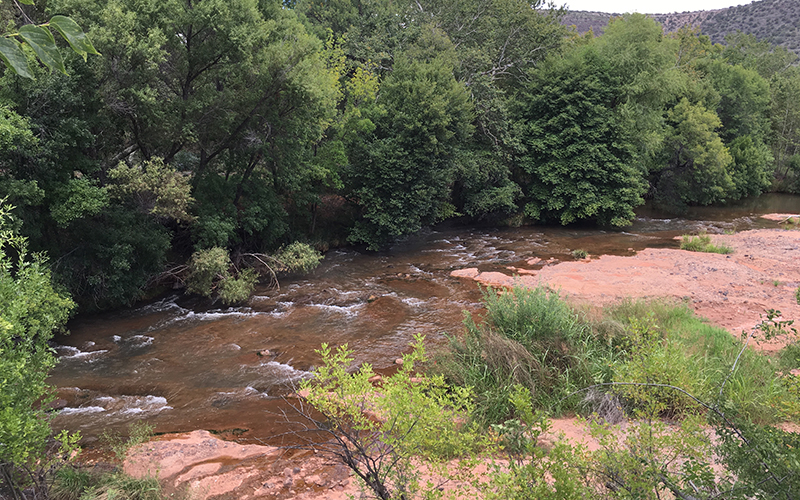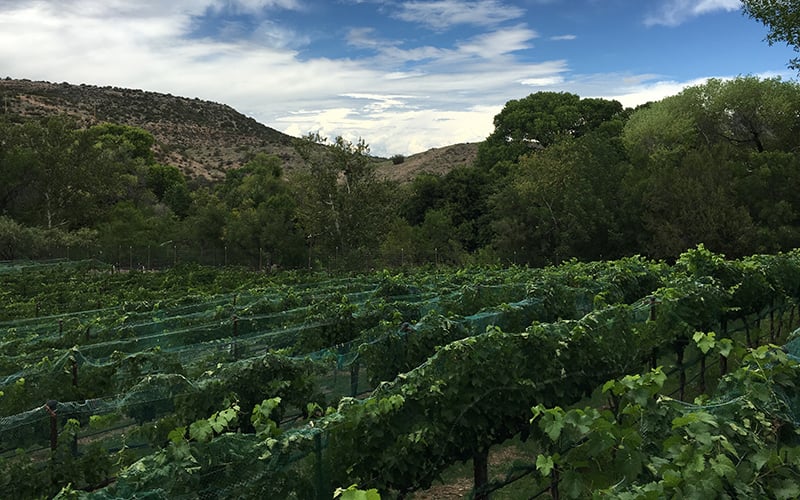
Grapes grow on the vines at Page Springs Vineyards, one of the business partners involved in a pilot water-conservation program in the Verde Valley. (Photo by Mindy Riesenberg/Cronkite News)

An advisory group in the Verde Valley is running a pilot program that pays people to conserve water. Members, left to right, include Clarkdale mayor Doug Von Gausig, Jocelyn Gibbon, Nikki Bagley and Steve Ayers. (Photo by Mindy Riesenberg/Cronkite News)

Page Springs wine, which may be familiar to diners around Arizona, gets its start in the Verde Valley. The vineyard is participating in a pilot water-conservation program. (Photo by Mindy Riesenberg/Cronkite News)

Chip Norton, a river conservationist with Friends of the Verde River Greenway, helped develop a pilot program to offer credits in exchange for saving water. (Photo by Mindy Riesenberg/Cronkite News)
VERDE VALLEY – The valley is tucked south of the red rocks of Sedona, lush with greenery and alive with wildlife that flock to the banks of the river running through it.
One of the last remaining continually flowing rivers in Arizona, the Verde River is a lifeline not just for otters, beavers and bald eagles, but also for residents of the cities and towns in the Verde Valley who rely on it for drinking water, household use and irrigation. The river also provides 40 percent of the surface water delivered to Phoenix residents annually, according to the Verde River Basin Partnership website.
Growth and a lack of regulation are threatening that lifeline. A group of public officials, conservationists and economic development experts have spent three years trying to figure out how to slow down the loss of the Verde River’s water. They pioneered a potential solution: a pilot program unique to Arizona that pays residents and business owners to conserve water.
If the plan works, others may one day mimic the concept in a state plagued by drought and overuse.
The program connects buyers and sellers. The seller agrees to reduce water usage by a certain amount, which can be sold to a buyer who needs the water. In the Verde Valley, a Cottonwood family has chosen not to irrigate its pasture for the next year. Two vineyards now get to use the water.
“The Verde River is ecologically irreplaceable, and we want to give our community members a stake in protecting the river for the future,” said Jocelyn Gibbon, a key organizer of the program.

A new water-exchange program based in the area offers credits to those who find creative ways to save water. (Photo by Mindy Riesenberg/Cronkite News)
Growth without regulation
Water levels have been rapidly dropping across Arizona, and 35 percent of the state’s river miles that once flowed freely no longer do so, according to a 2004 Nature Conservancy study. The study also says the seven major rivers in Arizona will go dry by 2050 if municipal pumping continues without constraint.
And the national advocacy group American Rivers has listed the Verde River as one of the ten most endangered rivers in America because of extensive groundwater pumping spurred by development.
Only six percent of Yavapai County, where most of the Verde River is located, is regulated by the 1980 Groundwater Management Act, which puts restrictions on the amount of water that may be pumped, according to a study by the University of Arizona’s agricultural college. The rest of the county’s water has no protection at all.
“Because we don’t have regulation, anyone can come in and drill a new well and pump as much as they want,” Gibbon said. “Population growth has just made it worse.”
Water for wine
Wine that makes its way to homes and restaurants in Arizona is a cornerstone of the pilot conservation program.
Page Springs Cellars Vineyards sits in the volcanic valley landscape overlooking Oak Creek near Sedona, where the Mediterranean climate and alkaline soils spawn critically acclaimed wines.
Page Springs’ owner, Eric Glomski, was a river restorationist before becoming a vintner, and was eager to be a part of the pilot program for the Verde River Exchange.
“In the big picture, the river to me is a gigantic indicator and metaphor for the condition of our landscape and our relationship to it,” Glomski said.
Here’s how it works: A local Cottonwood family decided not to irrigate its pasture, which normally uses 3 million gallons of water every year. The Nature Conservancy Arizona paid the family for the unused water based on the average market rate. Then, the conservancy’s partner, Friends of the Verde River Greenway, sold the water credits to Page Springs and another local vineyard. Now, they can water nearly 10 acres of vineyards with less impact on the area’s groundwater.

Page Springs Vineyards is reducing its water footprint by purchasing credits from a nearby family farm that has chosen not to irrigate all of its land in return for monetary credits. (Photo by Mindy Riesenberg/Cronkite News)
Glomski emphasized that protecting the Verde River isn’t just about irrigation and drinking water, but also about bolstering tourism and the economy in the area.
“People are more likely to come to Page Springs because there’s a beautiful stream running through my property,” said Glomski.
Nikki Bagley, who directs the wine program at Yavapai College, believes the Verde River program encourages the local, rapidly growing wine industry to be included in water conservation.
“Our growers here strive to have as little impact as possible,” Bagley said. “This program offers an opportunity for every business owner who wants to participate to show leadership and take responsibility for guarding the treasure that is the Verde River.”
Saving money in the shower
One day, Verde Valley residents may take shorter showers, water their lawns less frequently or use less well water in exchange for water-offset credits. For now, the advisory council is working on standards to create credits.
They will also seek more community partners to work on pilot projects next year, including businesses in the hospitality and beverage industries and private homeowners and landowners.
The advisory group developed the exchange by taking ideas from similar programs in the Northwest. They hope the Verde River strategy could spur other water conservation plans throughout Arizona.
“You can have a vibrant, growing economy without hurting the river,” said Clarkdale Mayor Doug Von Gausig. “When a healthy river and a healthy economy are dependent on one another, people will do what they can to save the river.”
Editor’s note: A previous version of this story included a photo caption that incorrectly identified the name of a waterway in the area. Oak Creek is a tributary of the Verde River.